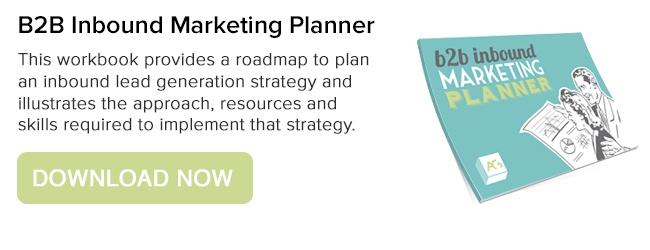"We're different, there's no-one else like us in the marketplace."
"As soon as people use our product, they'll want to buy."
"Our product is so good it sells itself."
When you're a marketer who works closely with companies in the SaaS/cloud technology space, you get used to hearing these phrases. Every emerging SaaS business is passionate about its product and convinced it has exactly what the market needs.
These businesses also buy into the widely accepted wisdom about the SaaS sales process, which goes something like this: it's much shorter and more transactional than traditional software sales, customers are ready to buy 'off the page' without the involvement of a salesperson, they just want to test out the product and then get started.
The result of this thinking is the ubiquity of the FREE TRIAL button.
You can see it on the home page, in the top navigation, and in the multiple calls to action that pop up across the website of almost every SaaS provider out there: Take a FREE TRIAL. Those are the words on the button, but what it actually says is "once you experience this product, WE KNOW you're going to buy it".
Sometimes, they're right. Occasionally, a SaaS product is genuinely so compelling that a customer will find it, try it and want to buy straightaway. And some people genuinely do land on a website, trial a product for a few minutes and decide to hand over their card details. For these products and for this type of customer, the free trial is the perfect way to generate leads and close business.
However, there are a lot of SaaS companies out there who aren't converting a high number of their free trial sign-ups into paying customers. They see a reasonably high percentage of site visitors agree to take a free trial (great), but not so many are willing to continue using the product - and pay for it - when the trial is over (not so good).
If you work for one of these companies, the good news is there's plenty you can do about it. Research tells us that best-in-class SaaS companies are able to convert 25% of free trial sign-ups into paying customers. Here are five possible reasons your trial isn't producing the goods:
1) Your Trial Exists in Isolation
When you're starting out, it's tempting to set up a website that offers a free trial and not much more. In fact, a quick glance at a handful of SaaS players - I'm thinking of companies like Kahootz, Workflow Max, Wrike - can give this impression. These sites are slick, well-oiled lead generation machines that invite the visitor to 'Get Started' (in other words, take a free trial) at every opportunity.
But look closer, and you can see there's a lot more going on. Each of these sites uses content to support its free trial offer. Content - in the form of blogs, videos and downloadable guides - helps you to stand out from your competitors (which could be many - remember, you're not that innovative). It's also the best way to attract potential customers still in the 'awareness' stage of the buying cycle: people who have identified the need to solve a problem, but are yet to evaluate potential solutions.
Without content, you can't educate these prospects about your product and why it is the best solution to their problem. Strong branding, effective design and an understanding of SEO will help you gain some visibility and attract visitors who are familiar with the marketplace, but these visitors are likely to simply shortlist your product along with others. To increase the chances of free trial users becoming customers, you need to educate them from the very beginning of their relationship with you.
Takeaway: Don't be all CTA with no "substance"
2) You're Not Leveraging Your Content
Remember the popular idea of SaaS sales - short, quick, transactional. This makes it tempting for SaaS companies to revert to the short 'buying funnel' by default, which means sending people directly to the free trial from every blog post and piece of content.
The problem is that not every visitor is ready for that - even in the SaaS world. And again, taking this approach means you lose the opportunity to educate prospects about why your product is the best fit for them. A lot of visitors may sign up for a free trial, but with little understanding of how your product in particular suits their needs.
Your content strategy needs to align with the different stages of the buying cycle, and reflect the fact that prospects may pass through those stages at different speeds.
Don't try to force everyone to the free trial as soon as they land on your blog - remember that some people are only just identifying their pain point and won't be actively seeking a solution. You need to play a longer game with these prospects, which leads us on to point three…
Takeaway: Different prospects will take different journeys to your free trial.
3) You Aren't Using Email Marketing to Engage and Nurture
If you're going to try educating and engaging prospects before you encourage them to take a free trial, your email marketing strategy needs to be rock solid. In fact, email is one of the best ways to reach out to people before, during and after the free trial period, so don't underestimate the power of communicating via a prospect's inbox.
When people download a piece of content at the top of the funnel, try automating an email workflow to send out a follow-up piece (say a selection guide) in a few days' time, and then introduce your free trial CTA.
For people who have already signed up, don't just fire off a single 'welcome' email at the beginning of the trial period. You don't want to bombard them, but it's fine to send two or three emails in the first week - providing your messages contain useful content designed to help people get value out of their trial. Try sending practical guidance and tips that encourage people to test certain features of your product.
Takeaway: Use email to lead people towards your free trial AND to keep them engaged once they sign up.
4) You Don't Offer a Demo
This is where you might have to face another uncomfortable truth and question whether your product really is 'so good it sells itself'. If you're struggling with a large abandon rate on your free trial, it's probably because people just aren't seeing the value when they use the product. There might be something in particular that frustrates them, in which case further development work may be required.
However, it could also be that some subtle complexity - or that one feature that really, really hooks new users in when they find it - just doesn't come across in the context of the free trial. Some people may have questions about your product they can't answer when left to their own devices.
The solution is to offer a demo alongside your free trial offer. Doing so can give prospects a helping hand and ensure they fully understand the capabilities of your product before they start using themselves. Companies like Xero do it really well - visitors are given the option of watching a two-minute video overview, and/or a series of feature demos, with the free trial CTA featuring prominently alongside.
Takeaway: Some people want to be shown how before they try it for themselves.
5) Your Free Trial Period is Too Long
The 30-day free trial has become fairly standard across the SaaS industry, but your trial doesn't have to be that length. It's all about finding the trial period that works for you i.e. the one that's going to drive the most conversions.
A lot will depend on the complexity of your product (for example, Salesforce offers a seven-day free trial for its entry-level Contact Manager edition, but the higher-end Performance edition comes with a 30-day trial).
It's easy to make an argument for a shorter trial period - you might be able to increase engagement if people know they have less time to try the product, and your sales cycle will also be shorter - providing you can convert them.
If you're already running a 30-day trial, study the usage statistics and see how many people actually take advantage of the full period. If they're logging in for the first few days only and then losing interest, it could be time to make a change.
Takeaway: Don't make your trial 30 days because everyone else does. Analyze the data to find out what works.
SaaS





-Aug-26-2022-07-52-29-78-PM.png)



